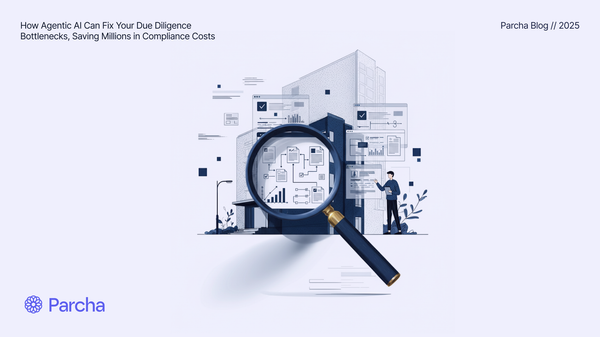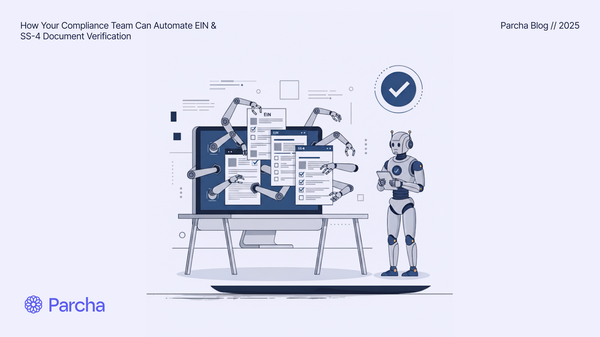Incorporation Document Verification: How to Cut Delays Without Cutting Corners

Regulations keep tightening, while old-school processes haven’t kept up.
Miss something, and you risk fines and/or reputational damage. Take too long, and clients walk away.
The good news? Smarter tools are now making it possible to:
- Move faster
- Stay fully compliant
- Keep clear audit trailsOnboarding new businesses shouldn’t feel like wading through endless PDFs and registry portals. But for most compliance teams, verifying incorporation and registration documents still eats up hours.
Here’s how forward-thinking compliance leaders are turning this tedious task into a smooth, auditable workflow.
The Growing Pressure on Compliance Teams
Verifying incorporation and registration documents is the first critical step in onboarding a new business client. And the stakes keep getting higher:
- Tighter regulations: AML, KYB, and CDD rules demand comprehensive verification before you can onboard any business customer. Skipping steps or cutting corners isn’t an option.
- Sheer volume: A mid-sized bank onboarding around 500 SMEs each quarter can spend hundreds of analyst hours digging through corporate registries, beneficial ownership documents, and filings from multiple jurisdictions.
- Rising scrutiny: Regulators expect more than a box-ticking exercise. They want clear proof of process. Who reviewed what, by which process, what was flagged or approved, and the reasoning behind it.
- High cost of mistakes: A single oversight could mean onboarding a high-risk or sanctioned entity. On the flip side, slow reviews frustrate legitimate customers and send them straight to faster competitors.
The result? Your team is stuck between escalating regulatory pressure and rising client expectations. While you’re still reliant on outdated, manual workflows.
Traditional Processes Can’t Keep Up
Traditional, manual verification is slow, error-prone, and expensive. You’re forced to rely on spreadsheets, PDFs, and siloed registry portals, creating friction at every step.
- Errors and rework: Duplicate checks and mistakes eat up analyst hours.
- Cross-border delays: Different registry formats and translation needs can stretch onboarding from hours to days.
- Weak audit trails: Inconsistent record-keeping makes it hard to prove compliance or respond to investigations.
For example, verifying a foreign LLC often means hopping between multiple registries, requesting translations, and reconciling conflicting data. By the time a decision is made, weeks may have passed. And the risk of missed red flags grows with every additional hour of delay.
Hence, you need state-of-the-art tools that’ve kept pace with both regulator and client expectations.
Automating Incorporation Document Verification
Manual verification might have worked a decade ago. But with hundreds or thousands of clients across jurisdictions, you need something faster and more reliable. That’s where automated verification tools can prove useful.
They integrate directly with global corporate registries, company databases, and sanctions lists to validate incorporation and registration documents in real time.
Instead of analysts toggling between siloed portals, automated AI agents pull data simultaneously from trusted sources, including:
- Government business registries
- OFAC and UN sanctions lists
- Adverse media databases
- Other jurisdiction-specific corporate records
Once these documents are ingested, AI-powered data capture kicks in. These tools automatically extract and standardize key fields like:
- Legal entity name
- Registration number and jurisdiction
- Incorporation date and status
- Beneficial owners and directors
This structured data forms a clean, auditable record without manual copy-pasting. If something doesn’t add up (say, a mismatched company name, an expired registration, or a missing beneficial ownership declaration) the system flags it instantly. Instead of discovering issues days later, your team is made aware of discrepancies upfront. This cuts down the usual back-and-forth with customers.
From Half a Day to Seconds: Automation in Action
Let’s say you’re onboarding a Singapore-based LLC. Within seconds, an AI agent can:
- Check ACRA’s registry (Accounting and Corporate Regulatory Authority) for incorporation details
- Cross-reference the entity against international sanctions lists
- Verify beneficial ownership against local filings
The same task would have taken an analyst half a day if done manually.
The efficiency gains are significant. According to Juniper Research, automation can reduce KYC and onboarding time by [up to 70%](https://www.appsrhino.com/blogs/how-ai-in-kyc-automation-is-used#:~:text=A recent report by Juniper Research indicates that banks utilizing AI-powered KYC solutions reduce onboarding time by over 70%25 while simultaneously reducing fraud losses by nearly 25%25.) while improving accuracy and auditability. That’s not just faster, it’s a strategic advantage in a market where clients expect near-instant onboarding.
Just as importantly, every step of the automated process is logged. You get a clear audit trail: which databases were queried, what data was pulled, which discrepancies were flagged, and how they were resolved (or escalated). This makes regulator conversations a lot less stressful.
Forward-thinking compliance teams are already deploying AI agents to handle the heavy lifting. Analysts can then focus their attention where it matters. Handling edge cases and high-risk entities, rather than repetitive data checks.
Building a Compliant, Scalable Workflow
Automation doesn’t replace human oversight but enhances it. Once the AI agent ingests documents, it follows a structured, regulator-ready process: querying trusted registries, extracting and standardizing key fields, flagging discrepancies, and maintaining a complete audit trail.
Your analysts stay in control, reviewing flagged items and making final decisions. While AI agents are left to handle the tedious and repetitive tasks.
The result is a scalable, compliant workflow that’s faster and more consistent.
You get clean data, real-time alerts, and clear proof of process. All without needing to add headcount.
Platforms like Parcha integrate these steps end to end, linking registry verification, ownership analysis, and document validation in one seamless flow. And because they plug into your existing compliance stack, you can modernize without disrupting what’s already working.
Ready to transform your document verification workflow?
Contact Parcha today to see how AI-driven compliance can work for you.





